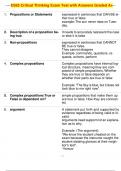D265 Critical Thinking Exam Test with Answers Graded A+
1. Propositions or Statements expressed in sentences that CAN BE ei-
ther true or false
example: The sun never rises on Tues-
day.
2. Description of a proposition be- It needs to accurately represent the case
ing true or else it is false
3. Non-propositions expressed in sentences that CANNOT
BE true or false.
They cannot disagree
Example: commands, questions, re-
quests, exhorts, perform
4. Complex propositions Complex propositions have internal log-
ical structure, meaning they are com-
posed of simple propositions. Whether
they are true or false depends on
whether their parts are true or false
Example: "The Sky is blue, but it does not
look blue to me right now".
5. Complex propositions True or simple propositions that make them up
False is dependent on? are true or false. How they are connect-
ed.
6. argument A statement put forth and supported by
evidence regardless of being valid or in-
valid.
Arguments need support not an explana-
tion as to why.
Example: (The argument)
"We know the student cheated on the
exam because the instructor caught the
student stealing glances at their neigh-
bor's test".
-Versus-
, D265 Critical Thinking Exam Test with Answers Graded A+
Explanation example: (Not an argument)
"The student only cheated on the exam
because their financial aid depends on
it".
7. premise Claims, evidence, and ideas intended to
provide support.
They are assumptions we are asked to
make.
"What's the point?"
8. Conclusion A claim that the whole argument is sup-
porting, providing or demonstrating.
"Thats the point"
9. premise indicator words because, since, in view of the fact, given
that, for the reason that, due to the fact
that, this follow, in that, for, as, as indicat-
ed
10. simple proposition Contains no internal logic structure,
meaning they are true or false on their
own, but based on how the world is.
example: The sky is blue.
11. Given that international tensions A new approach to diplomacy is needed.
are high, and as open military
conflict is growing more likely,
we can infer that a new approach
to diplomacy is needed. So let's
stop making the same mistakes
we always made in the past.
Which proposition is the conclu-
sion of the above argument.
12. Independent propositions indica- either...or...
tors if.....then...
but
, D265 Critical Thinking Exam Test with Answers Graded A+
and
or
13. mental heuristics Unconscious cognitive shortcuts for rea-
soning about something hard to think
about directly (the target attribute), by
reasoning instead about something else
connected to it that's easier to think
about (the heuristic attribute).
14. Conclusion indicators Therefore, Thus, so, it follows that, as
a result, we may conclude that, Hence,
entails that, implies that
15. Does the presence of an indicator No, because a conclusion may be inter-
word mean it follows what is indi- rupted by a clause stating a premise,
cated? vice versa.
Example:
16. The conclusion is always at the No, the conclusion is not always at the
end? end and the end is not always an argu-
ment.
17. Non-arguments includes explanations, stories, or sets of
statements, w/o an inference.
18. Inference/Inferring The process of making an inference,
an interpretation based on observations
and prior knowledge.
19. Deductive Argument Intend to prove their conclusions are
necessarily true.
20. Inductive Argument The premises demonstrate that their
conclusions
are probable.
Probable like: analogies, authority, sci-
entific reasoning
It commonly happens when we see




